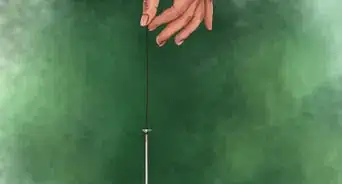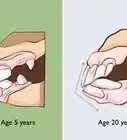This article was co-authored by Pippa Elliott, MRCVS. Dr. Elliott, BVMS, MRCVS is a veterinarian with over 30 years of experience in veterinary surgery and companion animal practice. She graduated from the University of Glasgow in 1987 with a degree in veterinary medicine and surgery. She has worked at the same animal clinic in her hometown for over 20 years.
This article has been viewed 248,804 times.
Mares come into heat during the spring when there is more light. During the spring and summer, a mare comes into heat approximately every 3 weeks. If you have a breeding mare or your mare has come into contact with a stallion during her heat cycle, you may want to determine if she is pregnant. The gestation period, or time a horse carries a foal, is 11 months, and mares do not begin to look round in the stomach until the last 3 months of pregnancy. This guideline provides instructions for checking mares for pregnancy.
Steps
Using Non-Chemical Methods to Check Mares for Pregnancy
-
1Check the mare's behavior around stallions. A mare who is suspected to be pregnant can be brought into contact with a stallion fourteen days after contact with the stallion to observe whether her behavior indicates possible pregnancy. If the mare is pregnant, she will likely refuse the advances of the stallion and not show her rear to the stallion as she would during heat.[1] Although it's good to be aware that a mare that is not in heat may also refuse the stallion's advances for other reasons.
-
2Watch your breeding mare for signs of heat. Some mares raise their tails, open and close the lips of the vulva, and squat to squirt urine or mucus in addition to becoming generally difficult during their heat cycles.[2] If the mare shows these behaviors 21 days after having been potentially impregnated, she is not pregnant.[3]Advertisement
-
3Have a veterinarian perform a transrectal palpation. A veterinarian can perform a transrectal palpation 16 to 19 days after the mare has been with a stallion. The vet puts his or her hand in the mare's rectum to check the uterus for indications of pregnancy. These indications include the size and/or shape of the uterus and the nature of the swellings on her ovaries.[4]
-
4Have a veterinarian use ultrasound to determine whether the mare is pregnant. An ultrasound requires the vet to insert a probe into the mare's rectum to take pictures that can confirm pregnancy. From 16 days, the pregnancy can be detected, and at 55 to 70 days they might be able to determine the sex.[5]
- The ultrasound uses sound waves to create a picture of the uterus and can monitor the heartbeat of a fetus.
- Ultrasound is the preferred method of telling whether a mare is pregnant, as it is the most reliable.[6]
Using Chemical Methods to Check Mares for Pregnancy
-
1Have a blood test performed on your mare. A pregnant mare can be checked for pregnancy hormones to determine pregnancy. This is especially useful when the mare is too irritable for non-chemical methods of determining pregnancy or when the rectum is too small for physical evaluation.[7]
- Have a veterinarian take a blood sample. The vet will send the blood sample to a laboratory and have it tested.
- Test the level of pregnant mare serum gonadotropin (PMSG) 40 to 100 days after your mare has been with a stallion.
- If your mare was pregnant but lost the fetus, the PMSG test may give inaccurate results.
- Analyze the level of oestrone sulphate 100 days after the breeding. Oestrone sulphate levels increase with the presence of a foal, but go back to normal if the fetus is aborted.
-
2Give your breeding mare a urine test. When checking mares for pregnancy, oestrone sulphate can be found in the mare's urine. A urine test can be performed by a veterinarian or using a home test.[8]
- Obtain a home pregnancy testing kit from a feed store or online.
- Test your breeding mare's urine 110 to 300 days after they have been with a stallion.
- Cut a 1 gallon (3.8 L) or 2-liter liquid container in half with a knife. Use the bottom to collect your mare's urine.
- Follow the directions on the pregnancy test kit to analyze your mare's urine. It takes 10 minutes to obtain the results.
-
3Confirm pregnancy test results. Using chemical-based tests can indicate that your mare is pregnant, but it is good to have another test performed by a vet—whether chemical or non-chemical—to ensure the foal has not slipped the foetus. Also, chemical-based tests are sometimes used improperly, so a positive result should be confirmed by a veterinarian.[9]
References
- ↑ http://horsetalk.co.nz/2012/10/11/options-pregnancy-testing-mares/#axzz3jJCMmplT
- ↑ http://www.equisearch.com/article/mares-in-heat-19155
- ↑ http://horsetalk.co.nz/2012/10/11/options-pregnancy-testing-mares/#axzz3jJCMmplT
- ↑ http://horsetalk.co.nz/2012/10/11/options-pregnancy-testing-mares/#axzz3jJCMmplT
- ↑ https://animals.mom.com/tell-looking-mare-pregnant-6562.html
- ↑ http://mvol.com.au/i/kenilworthvet/files/PREGNANCY%20TESTING%20MARES.pdf
- ↑ http://horsetalk.co.nz/2012/10/11/options-pregnancy-testing-mares/#axzz3jJCMmplT
- ↑ http://horsetalk.co.nz/2012/10/11/options-pregnancy-testing-mares/#axzz3jJCMmplT
- ↑ http://horsetalk.co.nz/2012/10/11/options-pregnancy-testing-mares/#axzz3jJCMmplT
About This Article
To check a mare for pregnancy, start by observing her around stallions 14 days after you think she’s been impregnated. If she refuses their advances, she may be pregnant. After 21 days, look for signs that she’s in heat, which means that she’s not pregnant. For example, behaviors like raising her tail, opening and closing the lips of her vulva, and squatting to squirt urine are usually signs of being in heat. However, make sure to confirm your observations by having your vet perform an ultrasound, which is the most reliable method of telling if a mare is pregnant. For more information from our Veterinary co-author, including how to administer a pregnancy test at home, read on!



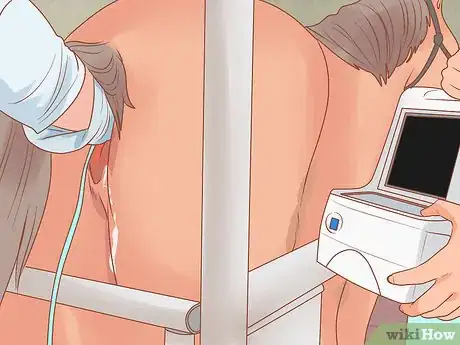
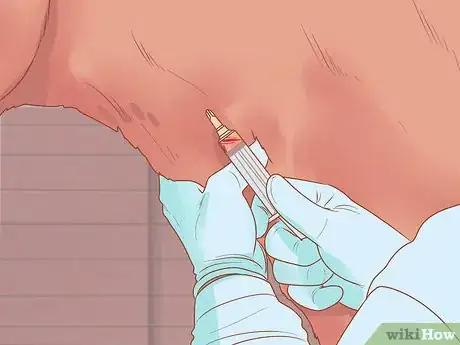
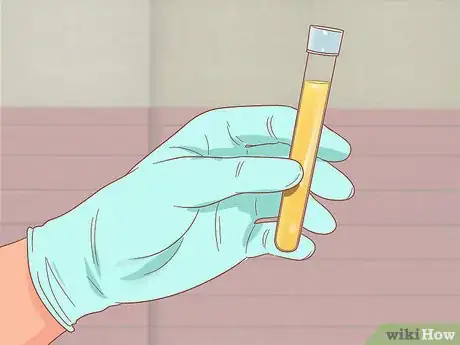
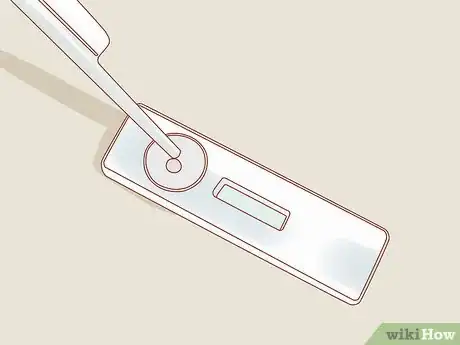




-in-Horses-Step-4-Version-2.webp)



